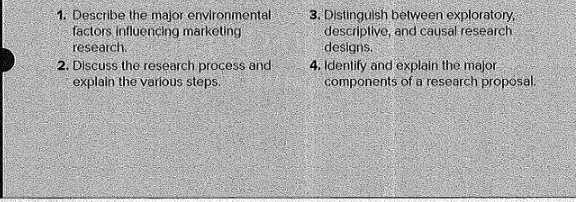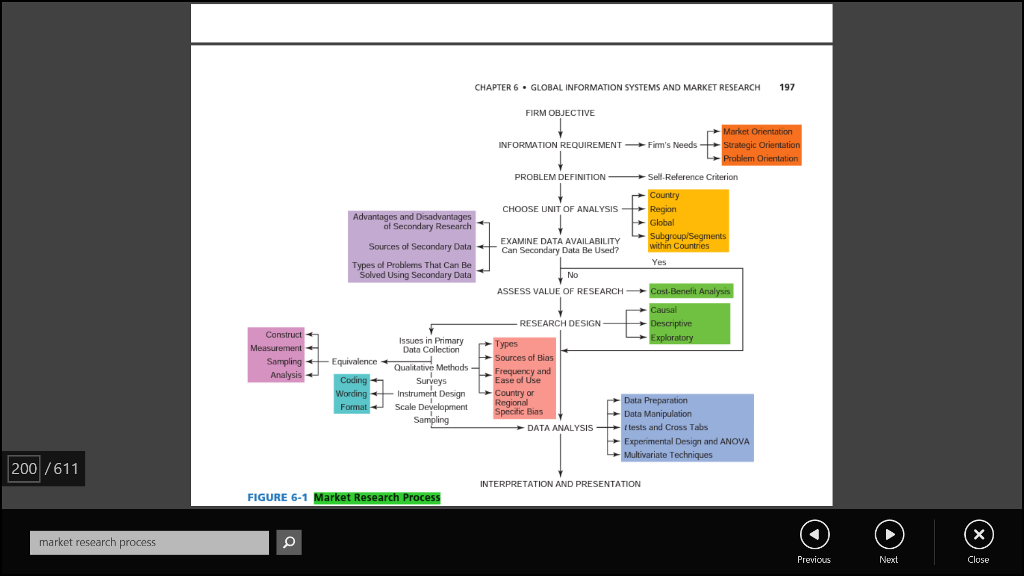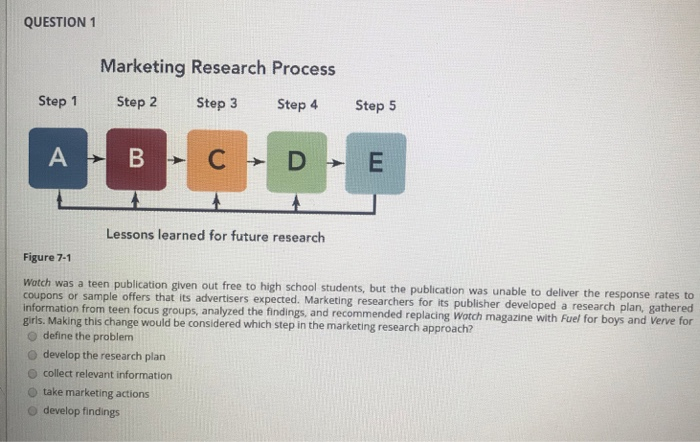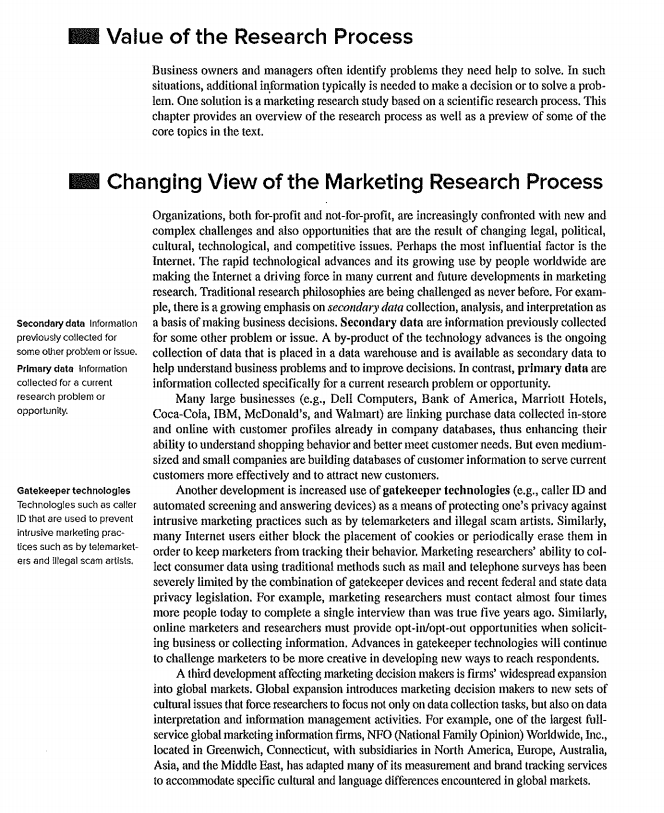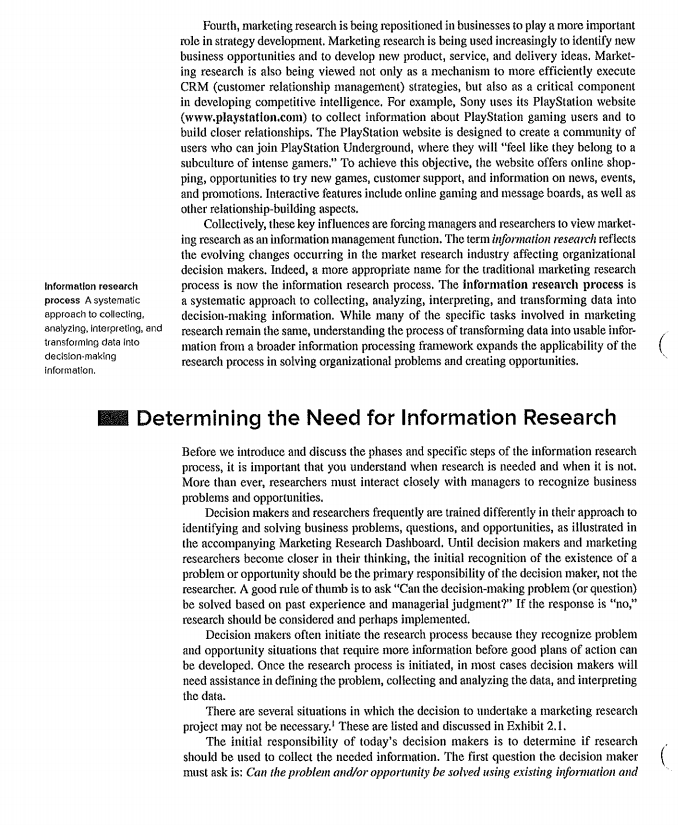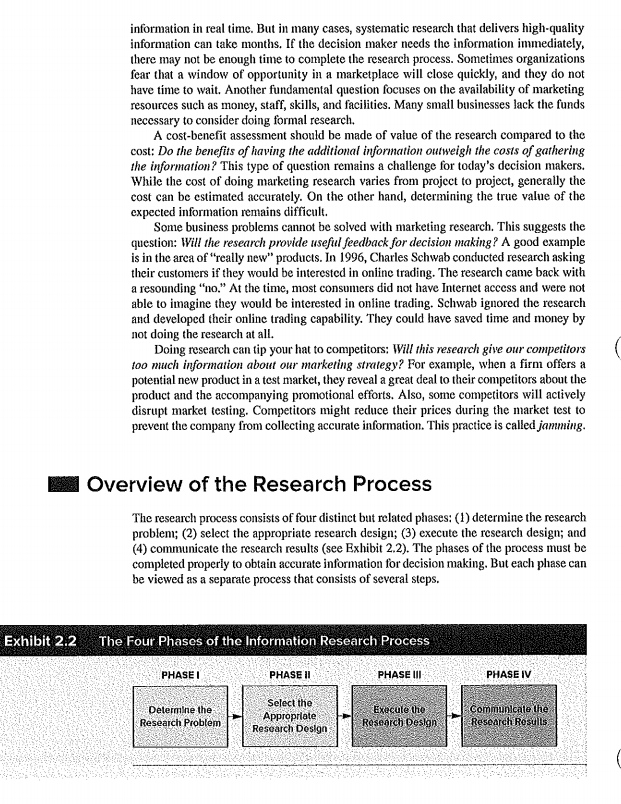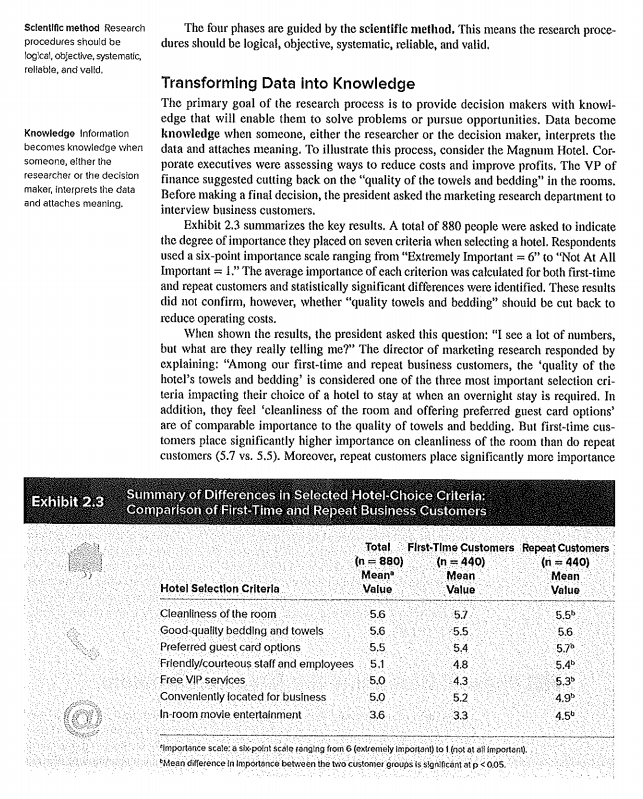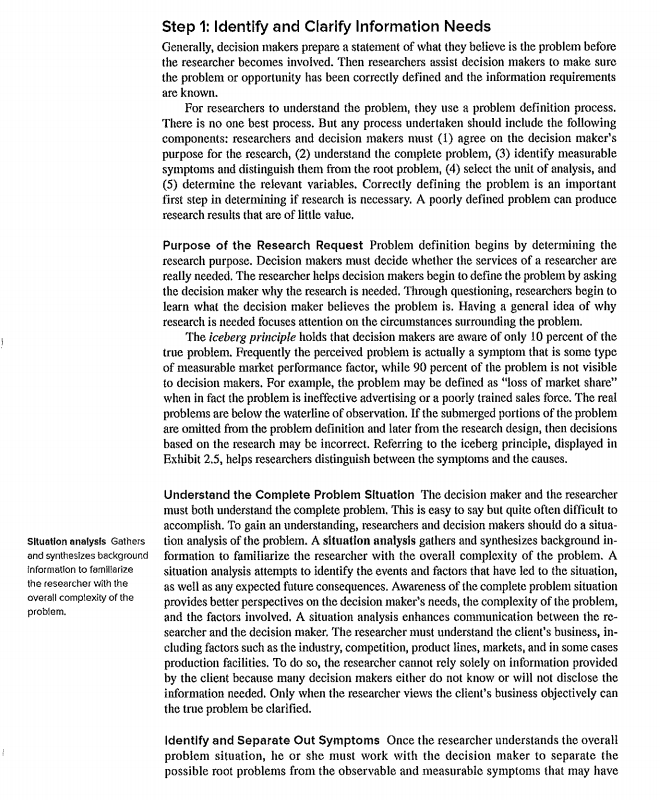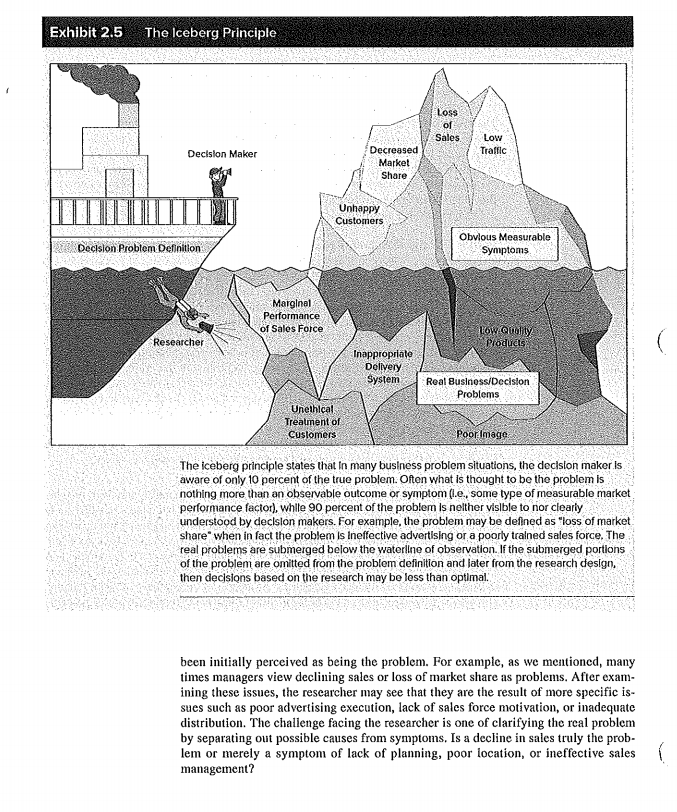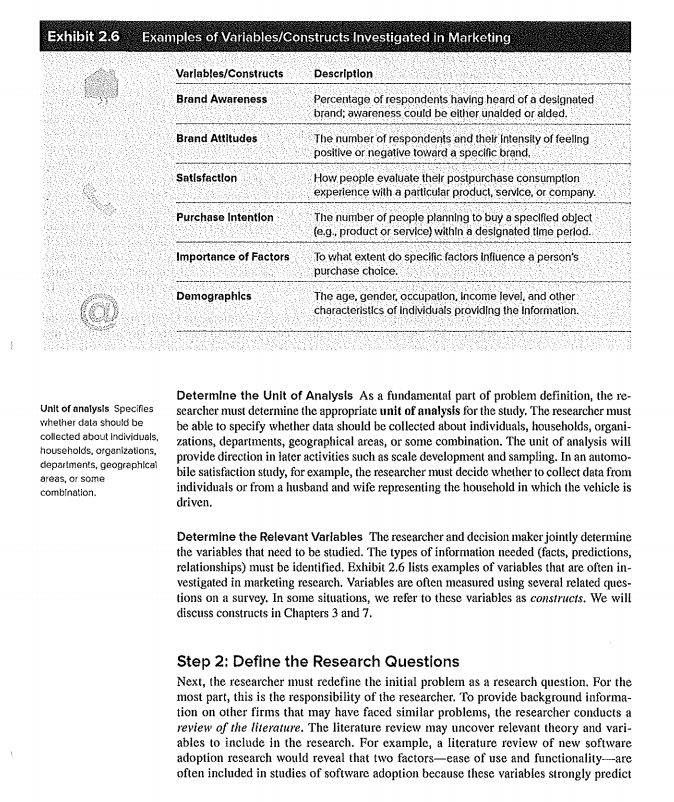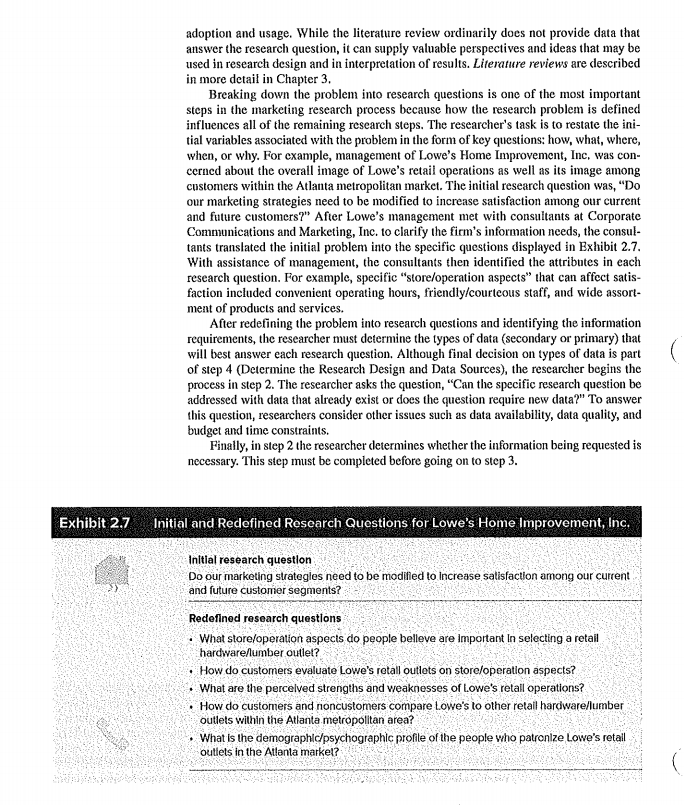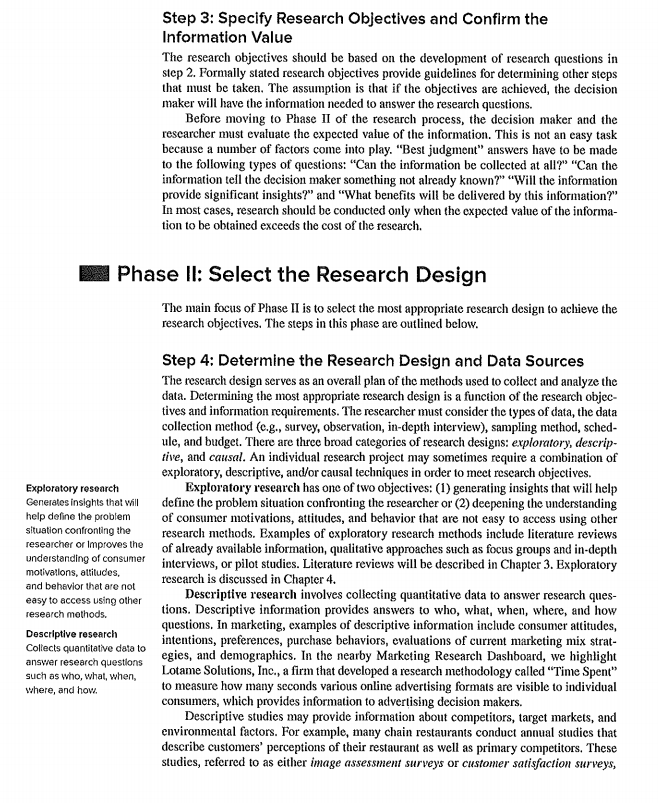MARKETING QUESTIONS......
1.
\fCHAPTER 6 . GLOBAL INFORMATION SYSTEMS AND MARKET RESEARCH 197 FIRM OBJECTIVE Market Orientation INFORMATION REQUIREMENT -Firm's Needs Problem Orientation PROBLEM DEFINITION + Sell-Reference Criterion Country CHOOSE UNIT OF ANALYSIS Region Advantages and Disadvantages of Secondary Research Global EXAMINE DATA AVAILABILITY Subgroup/Segments Sources of Secondary Data Can Secondary Data Be Used? within Countries Types of Problems That Can Be Yes Solved Using Secondary Data No ASSESS VALUE OF RESEARCH - Cost-Benefit Analysis Causal RESEARCH DESIGN- - Descriptive Construct Issues in Primary Exploratory Measurement Types Data Collection Sampling - Equivalence Sources of Bias Qualitative Methods Analysis Frequency and Coding Surveys Ease of Use Wording Instrument Design Country or Data Preparation Format Scale Development Regional Specific Bias Data Manipulation Sampling - DATA ANALYSIS tests and Cross Tabs Experimental Design and ANOVA Multivariate Techniques 200 /611 INTERPRETATION AND PRESENTATION FIGURE 6-1 Market Research Process market research process O O X Previous Next CloseQUESTION 1 Marketing Research Process Step 1 Step 2 Step 3 Step 4 Step 5 A B C D E Lessons learned for future research Figure 7-1 Watch was a teen publication given out free to high school students, but the publication was unable to deliver the response rates to coupons or sample offers that its advertisers expected. Marketing researchers for its publisher developed a research plan, gathered information from teen focus groups, analyzed the findings, and recommended replacing Watch magazine with Fuel for boys and Verve for girls. Making this change would be considered which step in the marketing research approach? O define the problem O develop the research plan O collect relevant information take marketing actions O develop findingsValue of the Research Process Business owners and managers often identify problems they need help to solve. In such situations, additional information typically is needed to make a decision or to solve a prob- lem. One solution is a marketing research study based on a scientific research process. This chapter provides an overview of the research process as well as a preview of some of the core topics in the text. Changing View of the Marketing Research Process Organizations, both for-profit and not-for-profit, are increasingly confronted with new and complex challenges and also opportunities that are the result of changing legal, political, cultural, technological, and competitive issues. Perhaps the most influential factor is the Internet. The rapid technological advances and its growing use by people worldwide are making the Internet a driving force in many current and future developments in marketing research. Traditional research philosophies are being challenged as never before. For exam- ple, there is a growing emphasis on secondary data collection, analysis, and interpretation as Secondary data Information a basis of making business decisions. Secondary data are information previously collected previously collected for or some other problem or issue. A by-product of the technology advances is the ongoing some other problem or issue. collection of data that is placed in a data warehouse and is available as secondary data to Primary data Information help understand business problems and to improve decisions. In contrast, primary data are collected for a current information collected specifically for a current research problem or opportunity. research problem or Many large businesses (e.g., Dell Computers, Bank of America, Marriott Hotels, opportunity. Coca-Cola, IBM, Mcdonald's, and Walmart) are linking purchase data collected in-store and online with customer profiles already in company databases, thus enhancing their ability to understand shopping behavior and better meet customer needs. But even medium- sized and small companies are building databases of customer information to serve current customers more effectively and to attract new customers. Gatekeeper technologies Another development is increased use of gatekeeper technologies (e.g., caller ID and Technologies such as caller automated screening and answering devices) as a means of protecting one's privacy against ID that are used to prevent intrusive marketing practices such as by telemarketers and illegal scam artists. Similarly, intrusive marketing prac- many Internet users either block the placement of cookies or periodically erase them in lices such as by telemarket- ers and Illegal scam artists. order to keep marketers from tracking their behavior. Marketing researchers' ability to col- lect consumer data using traditional methods such as mail and telephone surveys has been severely limited by the combination of gatekeeper devices and recent federal and state data privacy legislation. For example, marketing researchers must contact almost four times more people today to complete a single interview than was true five years ago. Similarly, online marketers and researchers must provide opt-in/opt-out opportunities when solicit- ing business or collecting information. Advances in gatekeeper technologies will continue to challenge marketers to be more creative in developing new ways to reach respondents. A third development affecting marketing decision makers is firms' widespread expansion into global markets. Global expansion introduces marketing decision makers to new sets of cultural issues that force researchers to focus not only on data collection tasks, but also on data interpretation and information management activities. For example, one of the largest full- service global marketing information firms, NFO (National Family Opinion) Worldwide, Inc., located in Greenwich, Connecticut, with subsidiaries in North America, Europe, Australia, Asia, and the Middle East, has adapted many of its measurement and brand tracking services to accommodate specific cultural and language differences encountered in global markets.Fourth, marketing research is being repositioned in businesses to play a more important role in strategy development. Marketing research is being used increasingly to identify new business opportunities and to develop new product, service, and delivery ideas. Market- ing research is also being viewed not only as a mechanism to more efficiently execute CRM (customer relationship management) strategies, but also as a critical component in developing competitive intelligence. For example, Sony uses its PlayStation website www.playstation.com) to collect information about PlayStation gaming users and to build closer relationships. The PlayStation website is designed to create a community of users who can join PlayStation Underground, where they will "feel like they belong to a subculture of intense gamers." To achieve this objective, the website offers online shop- ping, opportunities to try new games, customer support, and information on news, events, and promotions. Interactive features include online gaming and message boards, as well as other relationship-building aspects. Collectively, these key influences are forcing managers and researchers to view market- ing research as an information management function. The term information research reflects the evolving changes occurring in the market research industry affecting organizational decision makers. Indeed, a more appropriate name for the traditional marketing research Information research process is now the information research process. The information research process is process A systematic a systematic approach to collecting, analyzing, interpreting, and transforming data into approach to collecting. decision-making information. While many of the specific tasks involved in marketing analyzing, Interpreting, and research remain the same, understanding the process of transforming data into usable infor- transforming data Into mation from a broader information processing framework expands the applicability of the decision-making information. research process in solving organizational problems and creating opportunities. Determining the Need for Information Research Before we introduce and discuss the phases and specific steps of the information research process, it is important that you understand when research is needed and when it is not. More than ever, researchers must interact closely with managers to recognize business problems and opportunities. Decision makers and researchers frequently are trained differently in their approach to identifying and solving business problems, questions, and opportunities, as illustrated in the accompanying Marketing Research Dashboard. Until decision makers and marketing researchers become closer in their thinking, the initial recognition of the existence of a problem or opportunity should be the primary responsibility of the decision maker, not the researcher. A good rule of thumb is to ask "Can the decision-making problem (or question) be solved based on past experience and managerial judgment?" If the response is "no," research should be considered and perhaps implemented. Decision makers often initiate the research process because they recognize problem and opportunity situations that require more information before good plans of action can be developed. Once the research process is initiated, in most cases decision makers will need assistance in defining the problem, collecting and analyzing the data, and interpreting the data. There are several situations in which the decision to undertake a marketing research project may not be necessary.' These are listed and discussed in Exhibit 2.1. The initial responsibility of today's decision makers is to determine if research should be used to collect the needed information. The first question the decision maker must ask is: Can the problem and/or opportunity be solved using existing information andMARKETING RESEARCH DASHBOARD _ DECISION MAKERS AND RESEARCHERS Management Decision Makers . . . Marketing Researchers . . . Tend to be decision-oriented, Intultive thinkers who want Tend to be scientific, technical, analytical thinkers who love Information to confirm their decisions. They want addi- to explore new phenomena; accept prolonged Investiga- tional information now or "yesterday," as well as results tions to ensure completeness; focus on Information about about future market component behavior ("What will sales past behaviors ("Our trend has been . . ."* and are not cost be next year?"), while maintaining a frugal stance with conscious with additional Information ("You get what you regard to the cost of additional Information. Decision mak- pay for"). Researchers are results orlented but love sur- ers tend to be results oriented, do not like surprises, and prises; they tend to enjoy abstractions ("Our exponential lend to reject the Information when they are surprised. gain . . ."). the probably of occurrences ("May be," "Tends Their dominant concern Is market performance ("Aren't we to suggest that . . .]: and they advocate the proactive need number one yet?"}: they want information that allows cor- for continuous Inquiries Into market component changes, tainty ("Is It or isn't it?") and advocate being proactive but but feel most of the time that they are restricted to doing often allow problems to force them into reactive decision- reactive ("quick and dirty") investigations due to manage- making modes. ment's lack of vision and planning. managerial judgment? The focus is on deciding what type of information (secondary or primary) is required to answer the research question(s). In most cases, decision mak- ers should undertake the information research process any time they have a question or problem or believe there is an opportunity, but do not have the right information or are unwilling to rely on the information at hand to solve the problem. In reality, conducting secondary and primary research studies costs time, effort, and money. Another key mana- gerial question deals with the availability of existing information. With the assistance of the research expert, decision makers face the next question: Is adequate information avail- able within the company's internal record systems to address the problem? If the necessary marketing information is not available in the firm's internal record system, then a custom- ized marketing research project to obtain the information should be considered. With input from the research expert, decision makers must assess the time constraints associated with the problem/opportunity: Is there enough time to conduct the necessary research before the final managerial decision must be made? Decision makers often need Exhibit 2.1 Situations When Marketing Research Might Not Be Needed Situation Factors and Comments Insufficient time frames : When the discovery of a problem situation leaves Inadequate time to execute the necessary research activities, a decision maker may have to use Informed Judgment. Competitive actions/reactions sometimes emerge so fast that marketing research studies are not a feasible option.' Inadequate resources :When there are significant limitations in money, manpower, and/or facilities, then marketing research typically is not feasible. Costs outweigh the value When the benefits to be gained by conducting the research are not significantly greater than the costs, then marketing research is not feasible.information in real time. But in many cases, systematic research that delivers high-quality information can take months. If the decision maker needs the information immediately, there may not be enough time to complete the research process. Sometimes organizations fear that a window of opportunity in a marketplace will close quickly, and they do not have time to wait. Another fundamental question focuses on the availability of marketing resources such as money, staff, skills, and facilities. Many small businesses lack the funds necessary to consider doing formal research. A cost-benefit assessment should be made of value of the research compared to the cost: Do the benefits of having the additional information outweigh the costs of gathering the information? This type of question remains a challenge for today's decision makers. While the cost of doing marketing research varies from project to project, generally the cost can be estimated accurately. On the other hand, determining the true value of the expected information remains difficult. Some business problems cannot be solved with marketing research. This suggests the question: Will the research provide useful feedback for decision making? A good example is in the area of "really new" products. In 1996, Charles Schwab conducted research asking their customers if they would be interested in online trading. The research came back with a resounding "no." At the time, most consumers did not have Internet access and were not able to imagine they would be interested in online trading. Schwab ignored the research and developed their online trading capability. They could have saved time and money by not doing the research at all. Doing research can tip your hat to competitors: Will this research give our competitors too much information about our marketing strategy? For example, when a firm offers a potential new product in a test market, they reveal a great deal to their competitors about the product and the accompanying promotional efforts. Also, some competitors will actively disrupt market testing. Competitors might reduce their prices during the market test to prevent the company from collecting accurate information. This practice is called jamming. Overview of the Research Process The research process consists of four distinct but related phases: (1) determine the research problem; (2) select the appropriate research design; (3) execute the research design; and (4) communicate the research results (see Exhibit 2.2). The phases of the process must be completed properly to obtain accurate information for decision making. But each phase can be viewed as a separate process that consists of several steps. Exhibit 2.2 The Four Phases of the Information Research Process PHASE I PHASE I PHASE III PHASE IV Delemine the Select the Appropriate Execute the Communicate the Research Problem; Research Designs Research Design Research ResultsSclentlifle method Research The four phases are guided by the scientific method. This means the research proce- procedures should be dures should be logical, objective, systematic, reliable, and valid. ogical, objective, systemstic, rellable, and valid, Transforming Data into Knowledge The primary goal of the research process is to provide decision makers with knowl- edge that will enable them to solve problems or pursue opportunities. Data become Knowledge Information knowledge when someone, either the researcher or the decision maker, interprets the becomes knowledge when data and attaches meaning. To illustrate this process, consider the Magnum Hotel. Cor- someone, either the porate executives were assessing ways to reduce costs and improve profits. The VP of researcher or the decision finance suggested cutting back on the "quality of the towels and bedding" in the rooms. maker, interprets the data Before making a final decision, the president asked the marketing research department to and attaches meaning. interview business customers. Exhibit 2.3 summarizes the key results. A total of 880 people were asked to indicate the degree of importance they placed on seven criteria when selecting a hotel. Respondents used a six-point importance scale ranging from "Extremely Important = 6" to "Not At All Important = 1." The average importance of each criterion was calculated for both first-time and repeat customers and statistically significant differences were identified. These results did not confirm, however, whether "quality towels and bedding" should be cut back to reduce operating costs. When shown the results, the president asked this question: "I see a lot of numbers, but what are they really telling me?" The director of marketing research responded by explaining: "Among our first-time and repeat business customers, the 'quality of the hotel's towels and bedding' is considered one of the three most important selection cri- teria impacting their choice of a hotel to stay at when an overnight stay is required. In addition, they feel 'cleanliness of the room and offering preferred guest card options' are of comparable importance to the quality of towels and bedding. But first-time cus- tomers place significantly higher importance on cleanliness of the room than do repeat customers (5.7 vs. 5.5). Moreover, repeat customers place significantly more importance Exhibit 2.3 Summary of Differences in Selected Hotel-Choice Criteria; Comparison of First-Time and Repeat Business Customers Total First-Time Customers Repeat Customers (n = 880) (n = 440) (n = 440) Mean" Mean Mean Hotel Selection Criteria Value Value Value Cleanliness of the room 5.6 5.7 5.5 Good-quallly bedding and towels 5.6 5.5 5.6 Preferred guest card options 5.5 5.4 5.7h Friendly/courteous staff and employees 5.1 4.8 5.45 Free VIP services 5.0 4.3 5.35 Conveniently located for business 5.0 5.2 4.95 In-room movie entertainment 3.6 3.3 4.5 importance scale: a six point scale ranging from 6 (extremely Important) to 1 (not at all important. "Mean difference In Importance between the two customer groups is significant at p
